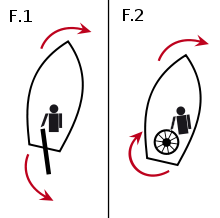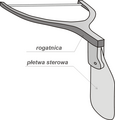Tiller (shipbuilding)

The tiller (also helm stick or rudder stick ) is the lever on watercraft with which the rudder is operated in order to steer the vehicle. The tiller and rudder are mostly connected in a common pivot point by a rudder shaft.
On sailing boats up to about 35 feet (approx. 10.5 meters) the tiller usually has a tiller arm (or simply a boom ): A stick is attached to the end of the tiller with a rotatable joint so that the tiller can be moved over this extension . This means that it can still be operated if the helmsman has to move away from it, for example when riding out . Outriggers are usually made of fiber-reinforced plastic or aluminum tubing and end in a T-handle. The Kolderstock was used until the 18th century to give the helmsman a better position.
If an outboard motor has the function of the rudder during operation and if it has a lever that is used to swivel the motor and on which the throttle grip and gear lever are usually also located, this lever is also known as a tiller.
A steering wheel is usually used to operate the rudder on larger boats and ships . While the desired change of direction is achieved here by turning the steering wheel in the same direction, the tiller steering must be steered in the opposite direction. If you want to turn to port , the tiller must be turned to starboard and vice versa.
Rigid connection of the tiller with the rudder on a felucca
Rudder stick in the aft intermediate deck of the Swedish galleon Vasa





